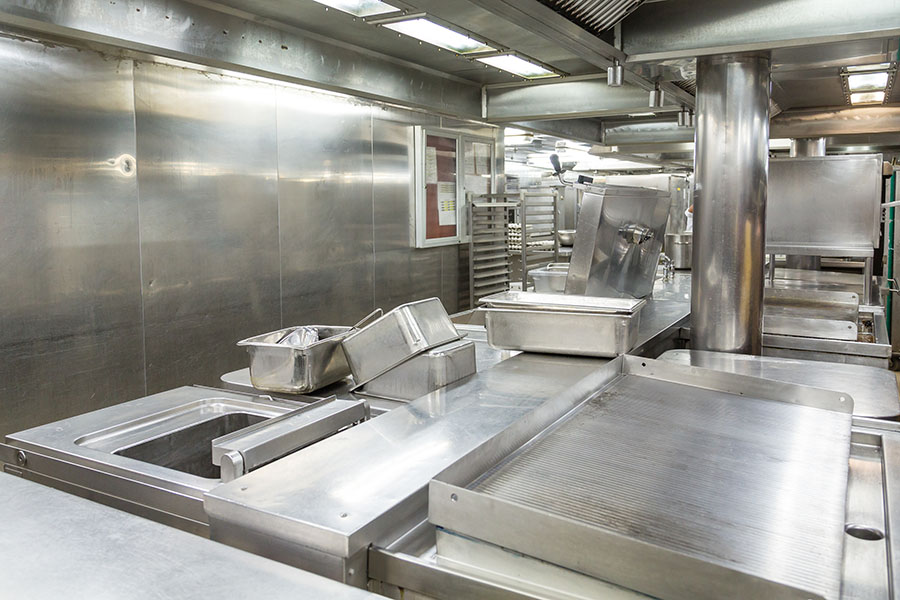(Editor’s note: This is the seventh installment in a series about opening a mobile pizzeria by Jason Cipriani, co-owner of Sips & Pies. You can read the other articles here.)
Each week, I’ve been covering decisions involved in opening a mobile pizzeria as if they exist in a silo. In reality, they’re all intertwined, and you’ll need to be working on or toward multiple tasks at the same time.
For instance, last week we discussed getting properly licensed, part of which would require a health department inspection that would hinge on a signed agreement with a local commissary kitchen.
It took us several months to find the right commissary kitchen to suit our needs. Below, I’ll walk through what we looked for, why we ultimately went with the kitchen we’re currently using and what to keep in mind as you begin looking for your mobile pizzeria’s home base.
Why Use a Commissary?
The first and most important reason you’ll want to use a commissary kitchen is because it’s likely required by your local health department. Some municipalities allow you to use your home kitchen as your commissary – in which case, I’m jealous of you.
Most health departments, however, require you to use a commercially approved and regulated kitchen to store and prepare food, do your dishes and dispose of any waste.
There are benefits to using a commissary kitchen. You don’t have to worry about the startup costs and monthly overhead that comes with operating a commercial kitchen.
Instead, you pay a monthly fee based on how much and how often you’ll use the kitchen. Outside of a loan for your truck or trailer (and, if needed, a truck to pull your trailer), your commissary fees could end up being your highest monthly bill.
Limited Commissary Options
There are three commissary kitchens in our town. Well, technically, there are only two. The third one is a dry bar that rents out extra kitchen space to entrepreneurs. Granted, we could have approached any Eagles or Elks lodge, a church or a local restaurant and asked how much they’d charge to use their space, but we wanted to do this right, with a legitimate commercial kitchen to call home.
Commissary A
The first kitchen we toured is the newest of the three. In fact, we toured it just a few months after it opened – well before we knew exactly what our end business would look like. It’s an old warehouse that was repurposed into a commercial kitchen with dry and cold storage for all types of businesses.
More specifically, it has 3,000 square feet of kitchen space, 6,000 square feet of freezer space, 2,000 square feet of refrigeration space and 4,000 square feet of dry storage.
There’s more than enough space so that, even if they have a lot of members, which they do, everyone can spread out and still get their product made.
Plans ranged from $125 per month for 10 hours of kitchen space plus additional fees for storage to $1,000 per month for an unlimited access plan with some storage included. That’s overkill for a business like ours, which currently sets up just a couple of times per month. But for someone who relies on a mobile pizzeria as their main source of income, it’s worth the investment.
Commissary B
We did a very quick tour of the commissary inside the dry bar’s kitchen and found that while there was spacious walk-in storage, the actual kitchen space was cramped and there was limited existing equipment. The biggest hurdle for this location: There wasn’t any room to store our dough mixer, which is very heavy; moving the mixer in and out of a kitchen just isn’t an option.
Pricing for the dry bar kitchen was around $50 for four hours of kitchen time, which had to be scheduled around their kitchen’s busy hours. We never even got to the point where we asked for cold and dry storage pricing.
We left that tour with our minds made up that it just wasn’t a good fit.
Commissary C
The third kitchen we toured took nearly six months to arrange. I started emailing the manager around the same time as the first kitchen, and I’d get a reply asking for a time to meet, and then nothing. I’d wait a week or so, reply asking for a new time, only to be told they were sorry I missed the last scheduled appointment. This cycle repeated a few times until I gave up.
Then this spring, my wife was able to get in touch with the manager and get a tour scheduled within a couple of emails. At first, we were very impressed with the space. It’s an old-school cafeteria with plenty of space and equipment spread throughout a big (but confined) area. There was limited dry-storage space simply due to the number of members and the space they used, but we were assured there was space for us.
The biggest hurdle was that each member’s cold storage consisted of a single- or double-door refrigerator – neither of which were big enough to fit full-size dough boxes – a critical requirement for us, as we cold-ferment our dough.
This was the only kitchen that required a 12-month contract, which was a tough idea to get on board with given I wouldn’t be using the space much at all during the Colorado winter.
Pricing started around $325 for nine hours of kitchen space per month including cold and dry storage. Each hour of that allotment would be another $15. There were bigger plans for those who needed more time and space.
The Winner Is …
Commissary A. It’s not perfect, and there are definitely things I would like to improve, but it offered the newest equipment, more space than we needed (even if that meant having to go on a hike to put our dough in the walk-in), and the pricing was right.
All in, we pay $212 per month. That breaks down to $150 for 10 hours of kitchen access, $20 for a pallet-sized area of dry storage and $42 for the same size area of cold storage space. We don’t pay for freezer space, but if we did, that would add an additional $52 per month to our tab.
If we go over our 10 hours, we’re billed at $15 per hour. It would take 66 overage hours – or 76 kitchen hours per month total – before we’d be better off signing up for the full $1,000 membership plan.
Be Realistic About You Needs
A mobile pizzeria doesn’t need a ton of space. At least, so far we haven’t. Our kitchen use is limited to a place to make and ball dough, which is roughly two tables next to each other.
Eventually, we may need to use one a burner or oven to prepare an ingredient for our pizza, but everything we use stays in cold and dry storage.
We do use a table to cut and prepare ingredients, such as garlic, basil and the like. And that’s pretty much it!
Maybe we overthought the entire thing and went for the biggest and newest, when in reality one of those lesser used commercial kitchens at a local church or lodge would have been more than enough for us.
After this season and our six-month contract is up, perhaps it’s something we’ll revisit. Then again, maybe not.
JASON CIPRIANI is the owner of Sips & Pies, a mobile wood-fired pizzeria serving Neapolitan-inspired pizza, in Colorado.



